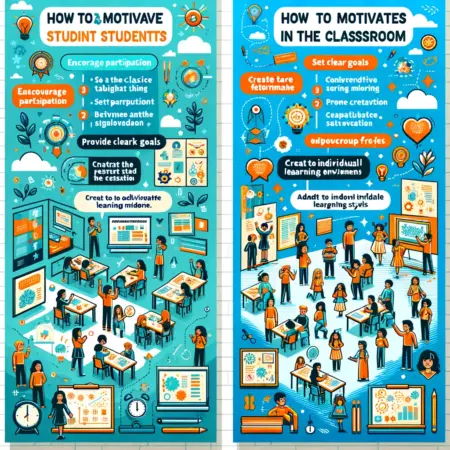The role of the teacher in teaching is not only to transmit knowledge and sow the reasonable, good, eternal, but also to non-violently motivate students for this very study. So much so that the student himself wants to study and strives to absorb useful information. What can be done to encourage children to study? Are there ways to motivate students who, at first, are not eager to gnaw on the granite of science?
How to Motivate Students in the Classroom

They are the only ones who can hold children’s attention: here, now, today, in this class.
- Encourage
Celebrate work in the classroom, demonstrate excellence, and convey positive feedback about children to their parents. Reward students for their success, create an honor board, give out a weekly bonus, or even start a teacher column in the school newspaper where you can talk about class work and student achievements.
- Strive for high quality.
Set high but realistic standards for students. Be sure to voice your expectations. Set short-term goals and celebrate their achievement.
- Infect students with your passion
Show your enthusiasm and help your students connect with it. For example, before explaining the term “alliteration” to the class, have students come up with names for their favorite objects using this technique.
- Organize your school day clearly
This is an obvious idea, but it needs to be stated again: use different teaching methods. All children are different, and each one needs an individual approach. To make learning more comfortable for everyone, create a clear daily routine – this will help maintain order in the classroom. For example, filling out a journal within 10 minutes before the start of the lesson; introduction to the topic of the lesson within 15 minutes; group discussion for 15 minutes; question and answer at the end of the lesson. This way, students know what to expect each day and become more organized.
- Distribute work in class
Together with your students, create a list of tasks for the week. Using the criteria of your choice, give students the opportunity to choose the type of class work for the next week:
- Listen to students’ ideas.
If students take responsibility for what happens in the classroom, they have fewer reasons to complain (of course, this cannot be completely avoided). Ask what they like to do during class, what helps them at work, what worries them afterward.
After analyzing the answers, integrate them into your lessons or brainstorm ways to understand how these ideas can be transferred to your lessons.
- Make Friday more free
You can use student ideas even more often. For example, students who have attended classes all week, completed all assignments, and followed all rules can vote on their choice of activities for Friday (lectures, discussions, watching a movie, playing a game, staging a scene from a play or movie).
- Relate lessons to real life.
Whether it’s budgeting for family holiday gifts, sharing stories about your city, or catching up on the latest pop culture, students will love school more if they can connect the learning experience with everyday life.
- Celebrate successes
In challenging classes, each day can feel like a battle of life or death, so try to remind students that they have come a long way. Set achievable, short-term goals, focus on improving results, allow students to evaluate themselves, and change what they find difficult to cope with.
- Praise them for their achievements outside of class.
You can and should study not only within the boundaries of school. Invite children to count the number of steps in their house, write an essay about their volunteering experience, how they felt during a sports competition, or choose any creative activity that students would like to complete.
- Plan your dream excursion
Brainstorm and think about traveling somewhere. The better the children perform in the class, the more challenging and longer the trip may be. Listen to your children’s opinions and go on an excursion that you yourself planned. Be sure to reward children for their activity, interest, good behavior, and allow them to leave feedback about the trip.
- Show that knowledge ensures the future.
Show the prospects of good study and confident knowledge. Let the student understand that with good skills and grades, he can get into his dream university much easier and faster. Or find application for your knowledge in a cool internship or study abroad.
Proven Ways to Motivate Students;How to Motivate Students in the Classroom

1. Create a favorable educational environment
The educational environment is a vague concept. For some, it is important to have a physical environment that inspires them to work. For example, a clean and organized work space or classroom. Some people manage to get into the right frame of mind in a cafe, listening to the city buzz and the voices of people, in quiet parks, co-working spaces, libraries or at home. For example, if you are a tutor, you can agree on lessons in a location that would promote productivity, and not, on the contrary, discourage the desire to learn.
Don’t forget about the psychological environment. Students should feel comfortable around you, so try to find a common language with the guys, do not criticize them in case of mistakes, but be in a mutually trusting dialogue.
2. Offer a variety of experiences/lesson scenarios/exercises
Monotonous work day after day in the same mode can be tiring, so some students become bored with studying over time. To keep students interested, vary lesson formats. Practice not only lectures, but include quizzes, organize projects, reports, excursions.
Don’t get hung up on one lesson plan, diversify the exercises, use modern technologies, group and pair work. The brain loves novelty, so juggling techniques will help maintain proper motivation.
3. Leverage student interests/strengths in learning.
This advice will be more relevant if you work individually. Based on the student’s interests, skills, or professional activities, you can tailor your lessons and connect the learning material to what is close to your student. You can also base your lessons on current topics, trends, and modern trends.
4. Track your progress
It can be difficult for students to see how far they have come, especially in subjects that are difficult for them. To do this, you can, for example, create a spreadsheet or a regular notebook, where the topics studied, as well as test results, will be entered in detail. Such tracking will be useful not only for students, but also for teachers. Educators can use this as a way to increase student motivation by allowing them to visually see how well they are learning and improving throughout the year.
5. Choose material that will be useful in real life
“Why do I need this?” If you often hear this question in class, it means the student is not involved in the process. If a student doesn’t think the material he’s learning is important, he won’t want to learn. Therefore, it is important to demonstrate how the subject relates to it. If you teach math, take the time to explore how it is used in practice—for example, in engineering—and share your findings with your students. Really surprise them by telling them that they can use the discipline knowledge in their career. When you show kids how the skills they’ve learned in a subject are used by “real” people every day, they begin to appreciate those lessons more.
6. Arrange challenges and include competitive moments in the lesson
To break up the routine, hold events, competitions, quests and games among his students. Healthy competition can be a great motivation for kids. As a rule, in such conditions, many open up and work more diligently in order to succeed. Bring more creativity, innovation and unpredictability to the learning process. This will encourage students to be more productive and creative.
7. Give students feedback
Students are not always able to understand the topic the first time. If they do poorly on your subject, don’t kill their spirit. Practice critical assessment and find where the problems are. Spend a little more time with students and celebrate effort, not just results. To motivate students, you must give them regular and timely feedback. This way they will better understand what is important to do to improve.
8. Keep in touch with parents of younger students
Motivation to study can be lacking for countless reasons. Talk to the students’ parents and find out more about them. Meaningful learning does not end within the four walls of the classroom, and your responsibility as a teacher does not end with collaborative exercises. Take it a step further and talk to your parents about problems at school. Perhaps in the conversation the features and details of the students’ lives will be revealed to you, which can subsequently be taken into account in teaching.
Conclusion
Motivating students in the classroom is an ongoing process that requires creativity, empathy, and adaptability from educators. By incorporating positive reinforcement, creating a supportive environment, using interactive methods, utilizing technology, encouraging goal setting, and emphasizing the relevance of learning, teachers can effectively inspire and motivate their students.
Creating a tabular guide is a great way to organize and present strategies for motivating students in the classroom. Here’s a simplified version:
| Strategy | Description | Example Implementation |
|---|---|---|
| Positive Environment | Foster a supportive and respectful classroom atmosphere. | Establish class rules together, show enthusiasm. |
| Clear Objectives and Expectations | Set and communicate clear, achievable goals. | Share learning objectives at the start of each lesson. |
| Varied Teaching Methods | Use different methods to cater to diverse learning styles. | Incorporate videos, group work, and hands-on activities. |
| Real-Life Connections | Relate learning material to real-world scenarios. | Discuss how topics apply in everyday life or future careers. |
| Constructive Feedback | Provide regular and positive feedback for improvement. | Offer specific praise and suggestions for improvement. |
| Student Autonomy | Allow students some choice and control over their learning. | Let students pick topics for projects or presentations. |
| Appropriate Challenge | Ensure tasks are neither too easy nor too hard. | Adjust difficulty based on student abilities and progress. |
| Achievement Recognition | Acknowledge and celebrate achievements, both big and small. | Use a “Student of the Week” board, give out certificates. |
| Relationship Building | Get to know students individually and show care. | Have one-on-one meetings, learn about their interests. |
| Growth Mindset Encouragement | Promote the idea that abilities can be developed through effort. | Praise effort and persistence, not just innate talent. |
| Gamification | Incorporate game-like elements in learning. | Implement point systems, educational games, or contests. |
| Real-World Examples and Guest Speakers | Use tangible examples and invite speakers to enhance subject relevance. | Invite professionals to talk about their experiences. |
| Collaborative Learning | Encourage group work and peer learning. | Assign group projects or peer review sessions. |
| Opportunities for Self-Expression | Allow students to express themselves creatively. | Offer assignments where students can choose the medium. |
This table offers a structured approach to understanding and applying various motivational strategies in the classroom. Tailoring these strategies to fit the specific needs and dynamics of your classroom will enhance their effectiveness.